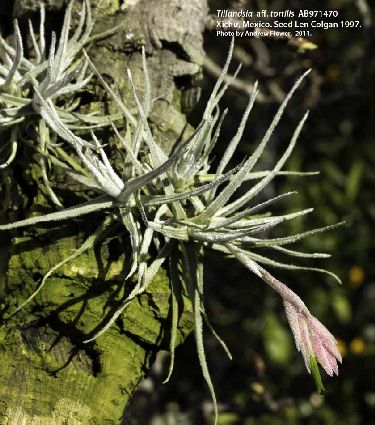
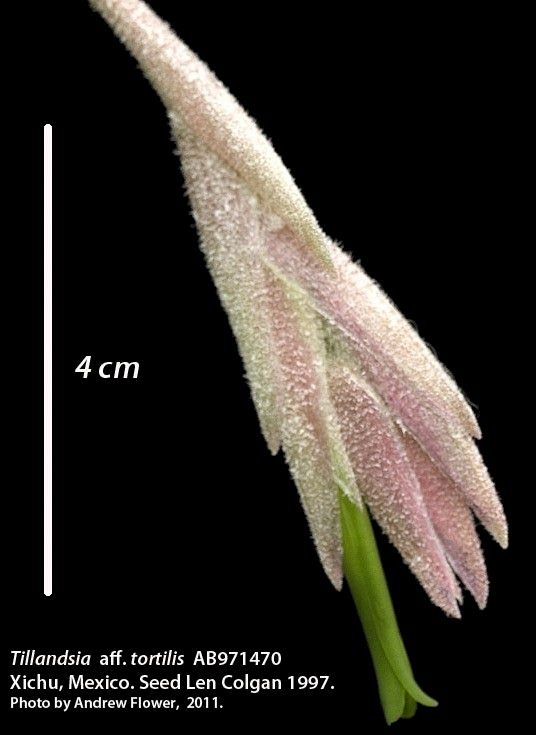
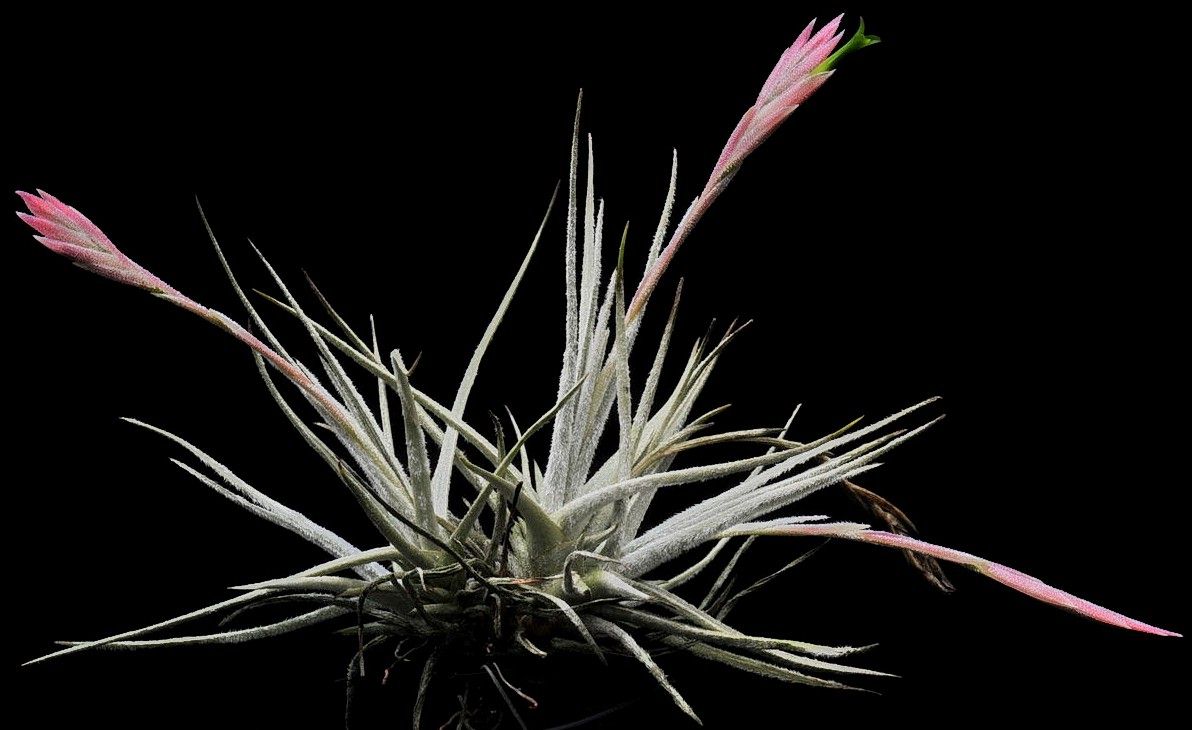
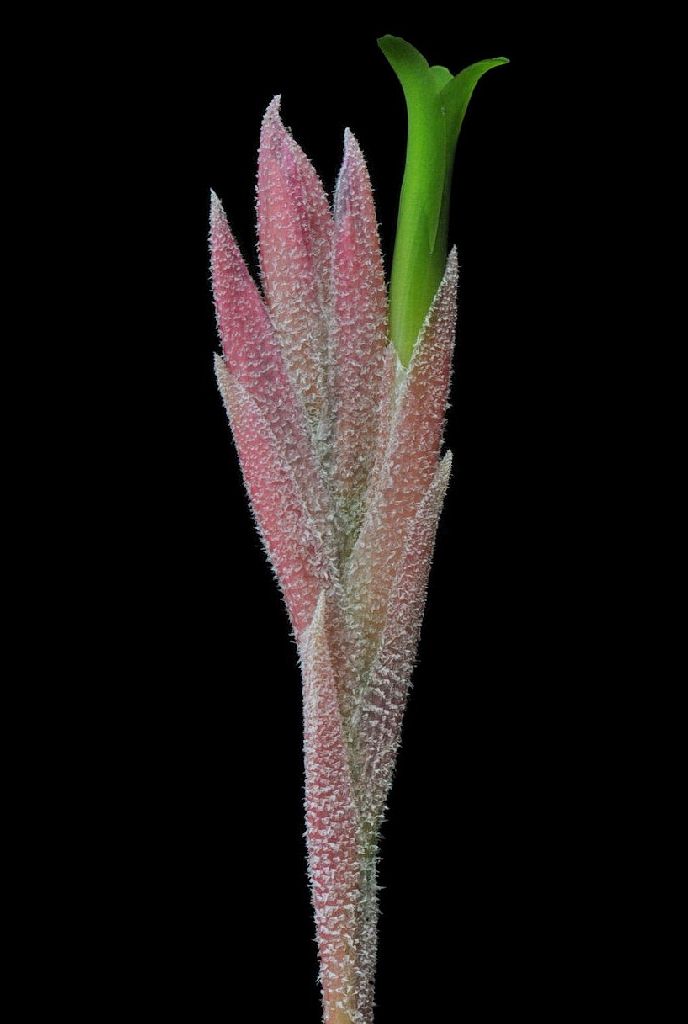
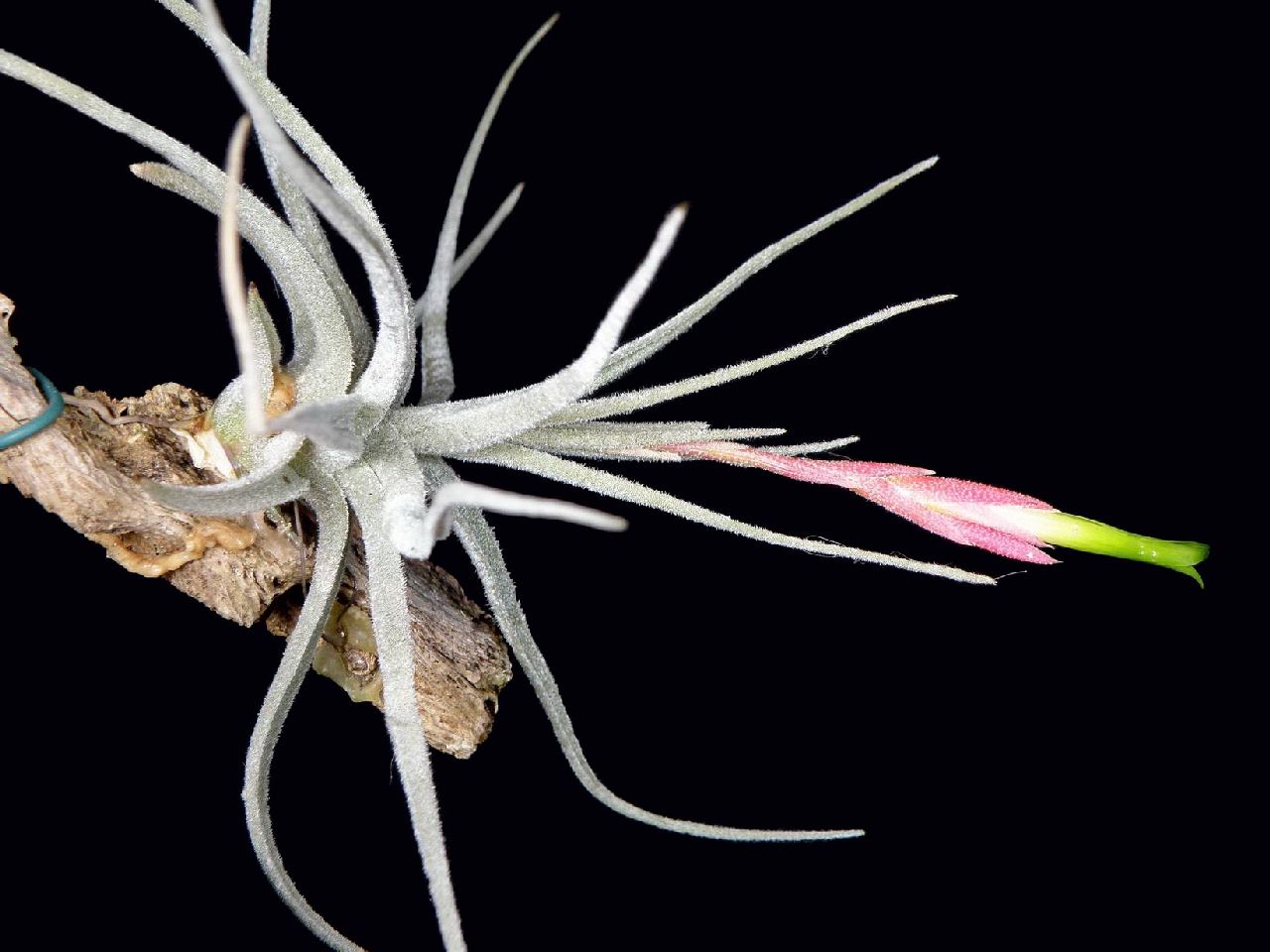
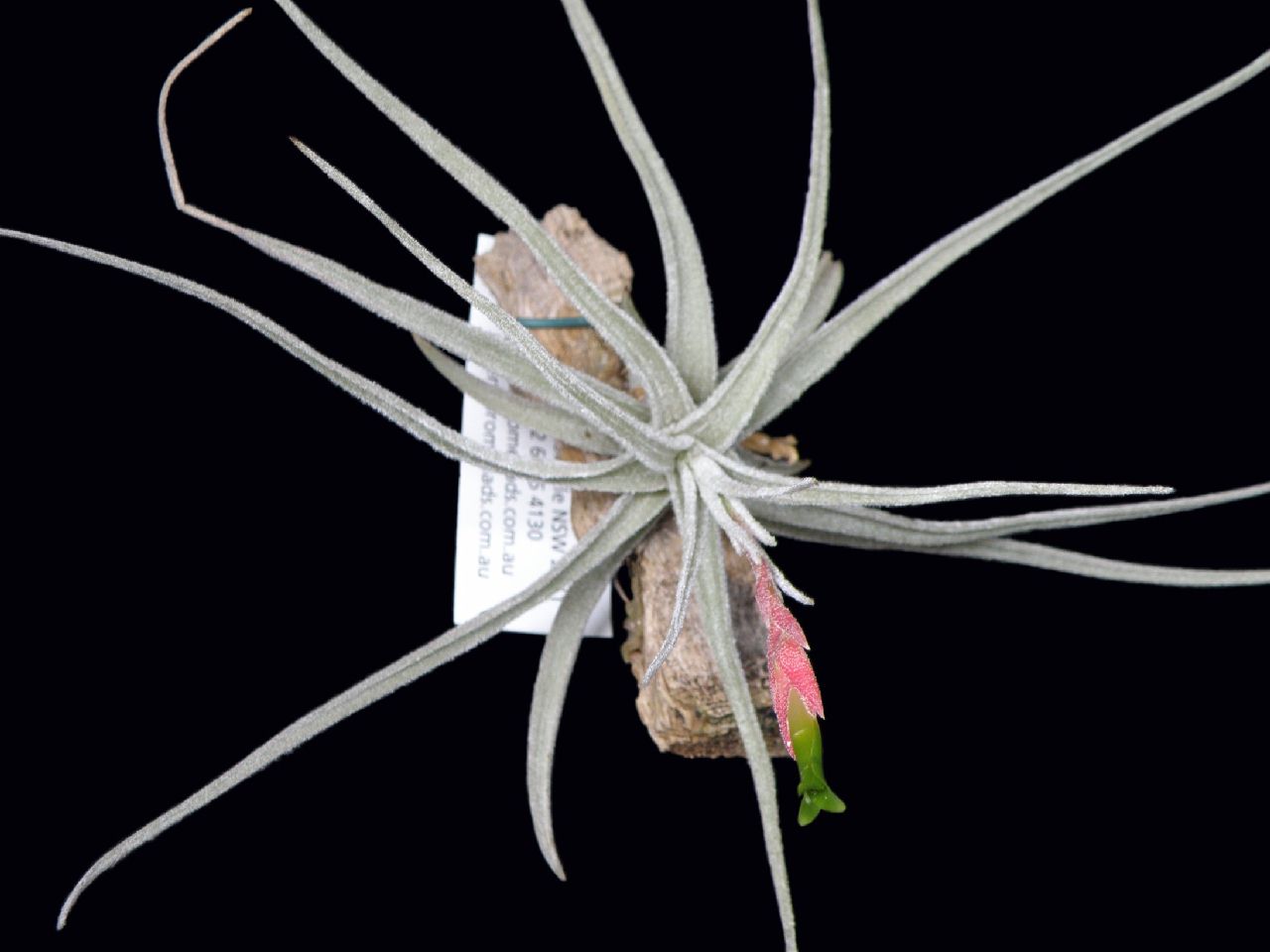
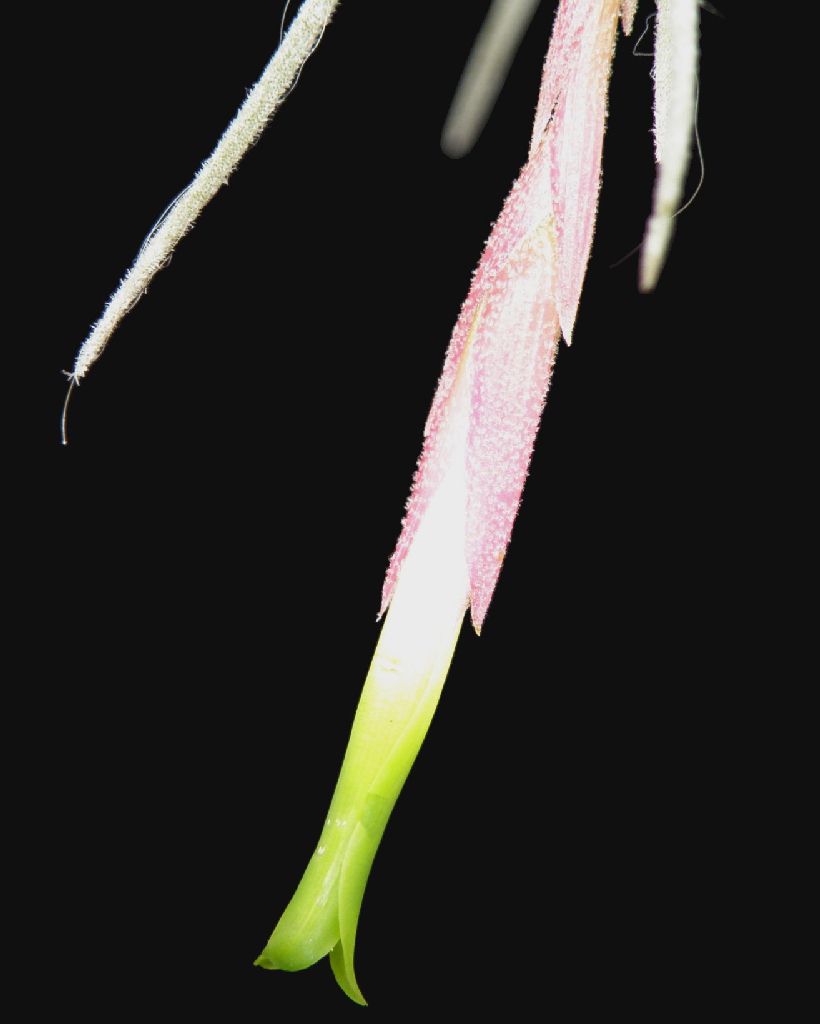
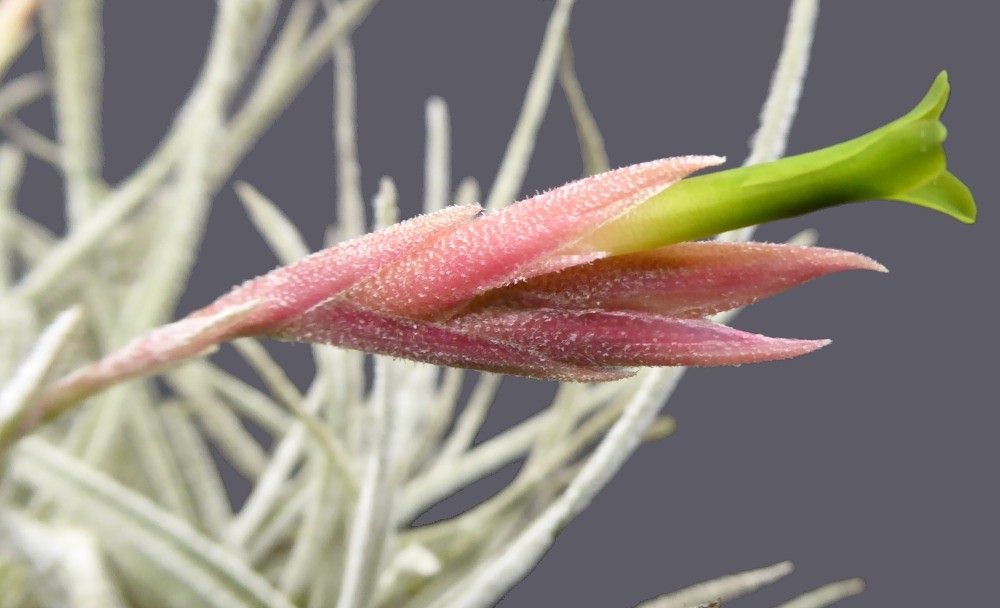
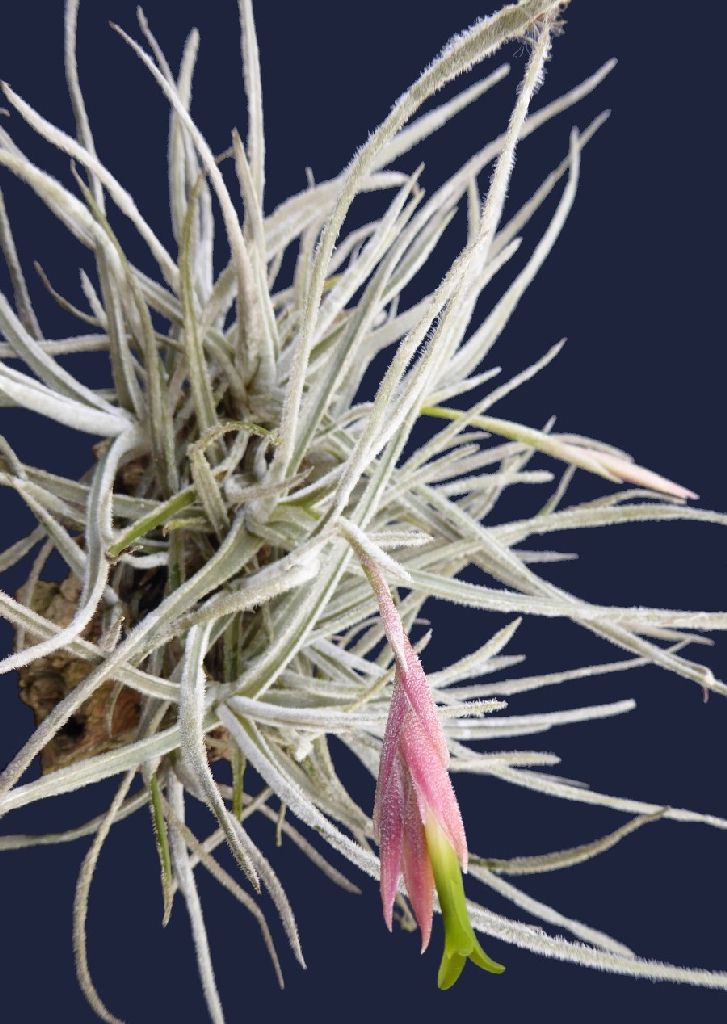
Andrew Flower ... "I'd say your calling your plant T. tortilis is pretty well on the nail.
Attached pics (Ed: top of this page) shows a plant grown from seed collected in Mexico by Big Len, labelled by him as "aff, tortilis" and one we have grown here for a long time as T. lepidosepala (I'm pretty sure our lepidos started life ex the BSI seed bank).
T. lepidosepala shown below for comparison.
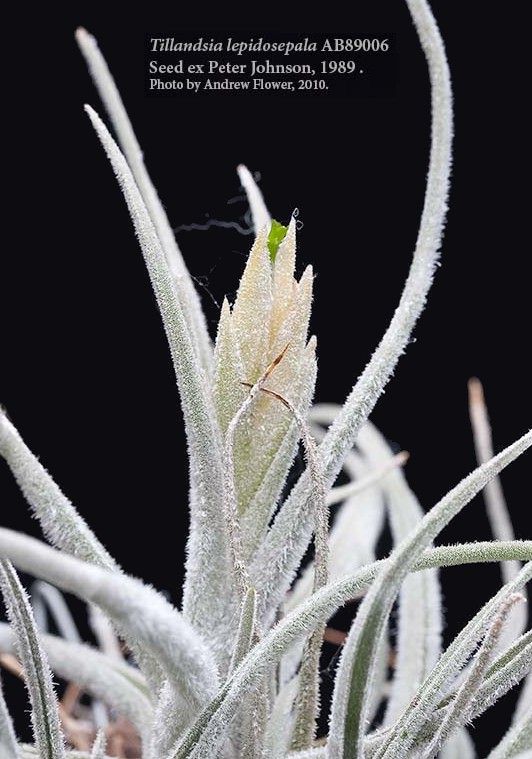
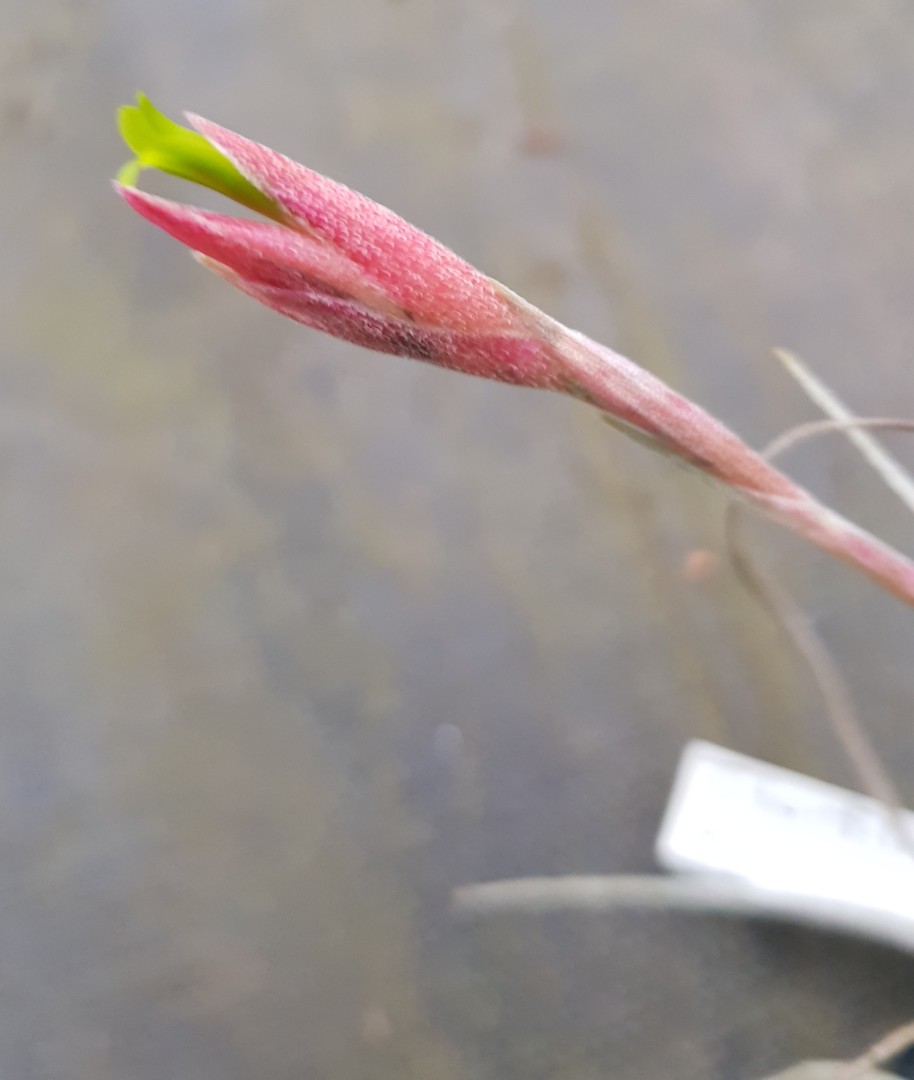
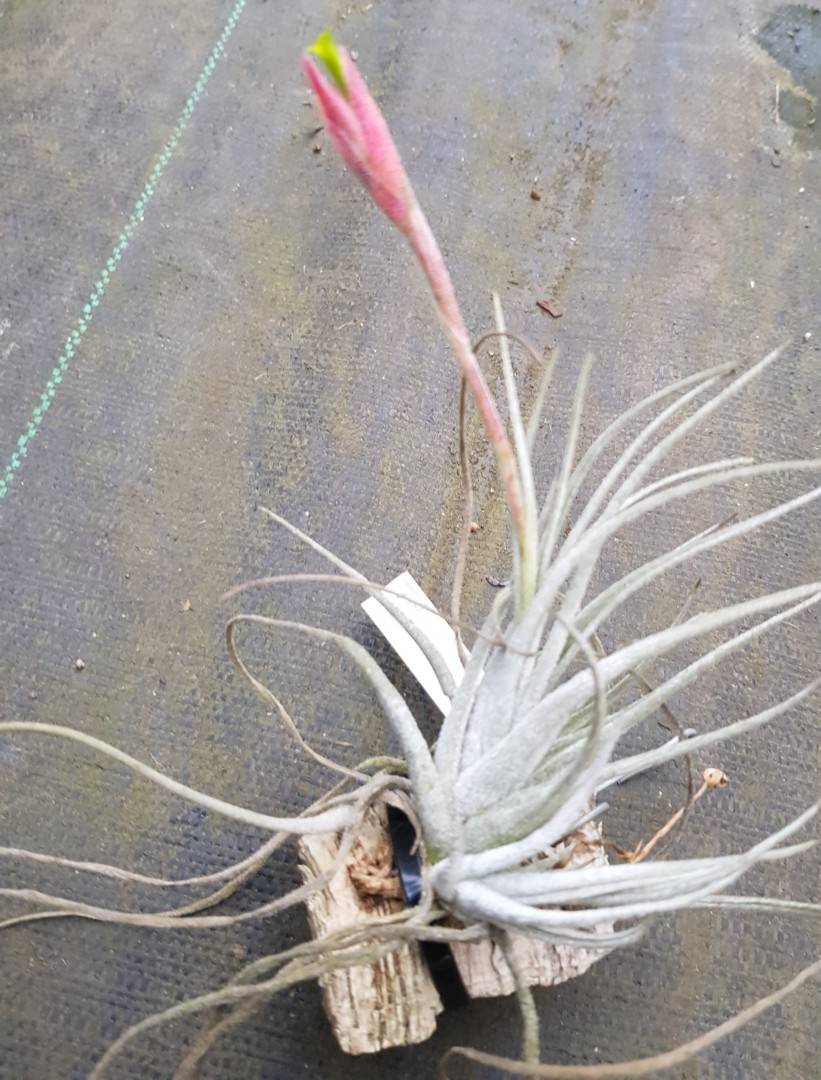
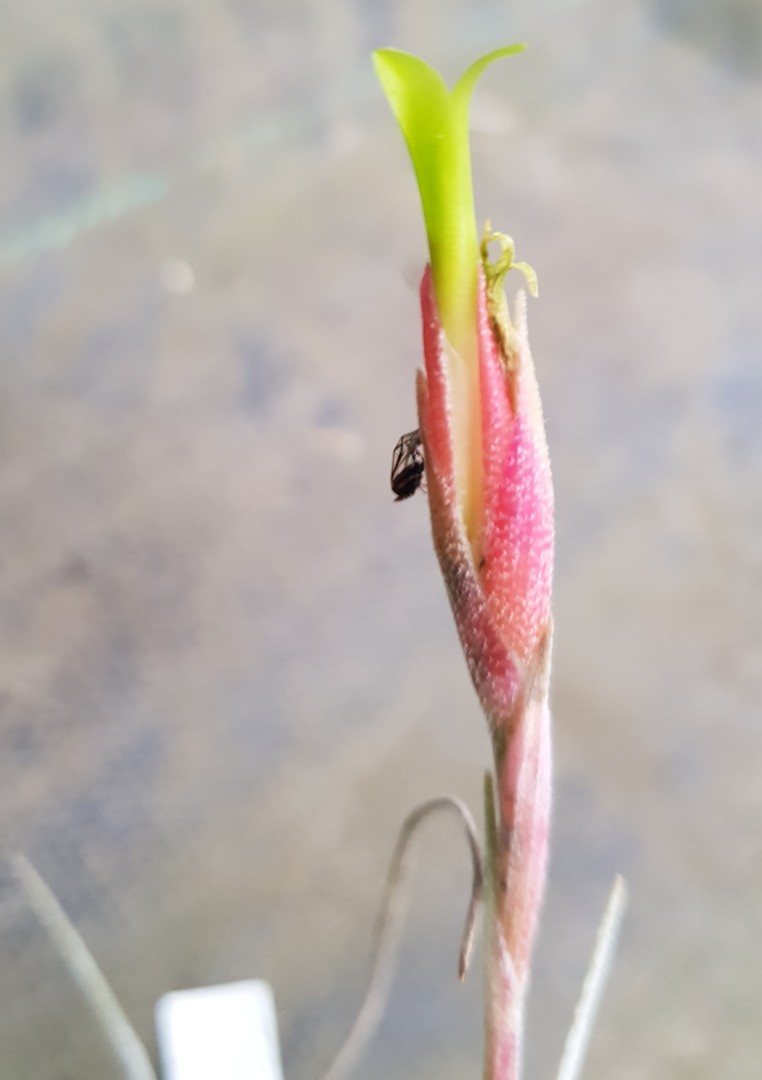
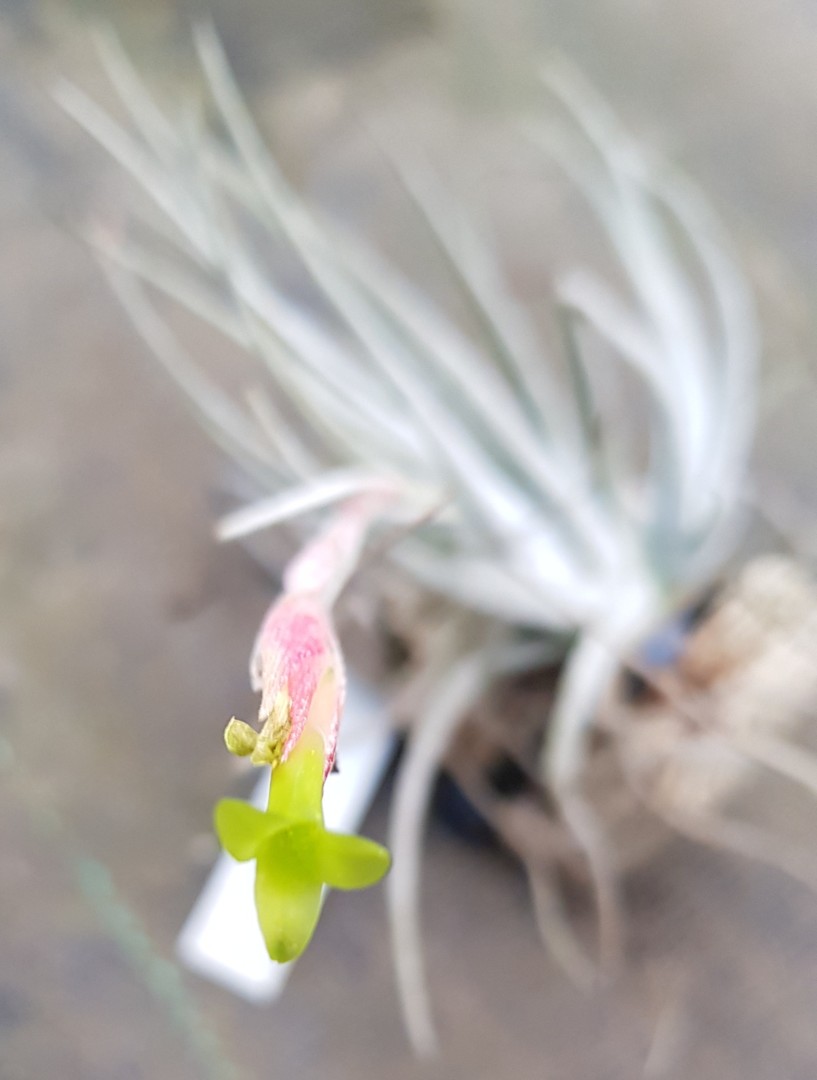
The descriptions by Smith (1977), Rauh (1990) and Gardner (1982) deviate clearly from each other in parts. Sepals according to Rauh and Smith are keeled, whereas Gardner states they are "ecarinate, only in some examples are they rear keeled". The length of the petals is evidently very variable. The description includes both these statements as well as everything present in the material from my collections.
Tillandsia tortilis was formerly known as T. ehrenbergii (K. Koch) Klotsch ex Mez, and many readers know the plant under this name or cultivate them in their own collections, possibly for a long time. It was not until 1986 that Walter Till stated in his detailed article: "What is Tillandsia ehrenbergii?" that this plant's name was unjustified and that the older name T. tortilis Klotzsch ex Baker must be the valid one. Dr. Till had checked all herbarium specimens and types carefully and he finally clarified that the plant must be called Tillandsia tortilis Klotzsch ex Baker.
Species name - The species name "tortilis" comes from Latin and means twisted. This refers to the winding leaves.
Habitat and Range - In central Mexico, in the highlands of the States of Aguascalientes, Durango, Hidalgo, Jalisco, Queretaro, San Luis Potosi and Zacatecas. The plant grows as an epiphyte as well as a lithophyte and usually in large groups or clumps.
Cultivation - T. tortilis is a bit delicate in culture. In winter it should be kept not too moist, in summer it can be cultivated outside.
Variability - The species is very variable. There are areas in which the plants are very large and strong, as for example in Guanajuato near Xichu, where they are very often exposed to extreme cold and fog in the local hilly highlands. These strong plants also have large inflorescences with long and wide swords that sometimes have a second, smaller additional spike. Also the floral bracts and petals are extremely large. I have found petals to 3.8 cm long. McVaugh states in his description of the plant for petals to be even 4 cm long. In addition, the rock-loving forms that grow between San Luis Potosi and Zacatecas, are extremely large in all characteristics. There, we could observe rocks that are completely overgrown with gigantic groups of this form.
Plants from other areas are sometimes very small and fine leaved. As I write these lines, I have a plant from San Regla, Hidalgo, in front of me. It is a large, ball-like clump of at least 20 delicate plants. If one doesn't look exactly at the inflorescence, one could think, that it is Tillandsia schiedeana! But then one discovers the small pink sword with the green blooms - and it is Tillandsia tortilis, but a form that is extremely small in all characteristics, as well as the flower.
It is also interesting that in the type locality you often find Tillandsia lepidosepala. At several locations, I could find plants of both species in the immediate neighbourhood, for example in Venados valley, near San Miguel Regla and near Guanajuato. In the habitat these two species are very similar, and vegetatively, it is often not easy to distinguish them. Also the lepidote (scaled) sepals, which gave the species its name, are found in both species.
Only when you investigate the inflorescences you can determine that Tillandsia lepidosepala has quite a short peduncle, the flower spike is shorter and much broader, the floral bract colour does not pale even in Mexico, where they remain yellow or green, while with T. tortilis it is shiny pink, the petals are a much smaller, darker green and the tips are not bent outwards.
Examined material
Hidalgo: Pachuca, Marz 1977, Ehlers EM7840 (WU); Venadostal, Marz 1978, Ehlers EM 7840 (WU); Venadostal, 28.3.1988, Ehlers EM880304 (WU); Venadostal, 20.11.2003, Ehlers EM000305 (WU); Actopan - St. Atotomilco el Grande, 2130 m, 23.2.2006, Ehlers EM061901 (WU); San Miguel Regla, 2000 m, 23.2.2006, Ehlers EM061902 (WU); Santa Maria Regla, 1900 m, 23.02.2004, Ehlers EM032203 (WU); Hacienda Santa Maria Regla, 1850 m, Febr. 2003, M. Kretz 242 (WU).
Zacatecas: Zacatecas - San Luis Potosi, epilithic, Ehlers EM7844 (WU); San Luis Potosi- Zacatecas, km 55, Marz 1985, Ehlers EM850401 (WU); San Luis Potosi, Mex 59, km 51, 2100 m, Manfred Kretz 230 (WU); Huejuquilla, 2230 m, 2.12.2000, Ehlers EM001501 (WU).
Guanajuato: Xichu, 2155 m, epiphytic, 12.3.1994, Ehlers EM941701 (WU); Xichu, 2250 m, epiphytic, 18.2.2006, Ehlers EM061503 (WU); San Juan de los Llanos, 2100 m, 25.3 1998, Ehlers EM982203 (WU); Sierra de Cubo, 2050 m, 26.3.1998, Ehlers EM982203 (WU); Guanajuato-Hidalgo, 2420 m, epilithic, 18.2.2006, Ehlers EM061501 (WU); San Felipe-Silao, 1900 m, epilithic, 20.2.2006, Ehlers EM061701 (WU); Ixmiquilpan-Tolontongo, 2000 m, epilithic, 21.2.2006, Ehlers EM061803 (WU).
Queretaro: San Juan del Rio, 2200 m, 14.2.2007, Ehlers EM072001 (WU).
Tillandsia tortilis Klotzsch ex Baker, J. Bot (London) 25: 237 (1887), non "Klotzsch ex Beer" 1856 (nomen!), non "Brongniart ex Morren" 1878 (nomen!)
Platystachys tortile BEER, Bromel. 266 (1856), nomen.
Platystachys ehrenbergii BEER, Bromel. 264 (1856), nomen.
Tillandsia tortilis "Klotzsch ex Beer”, Bromel. 266 (1856), (B, n.v.), nomen.
Tillandsia ehrenbergii "Klotzsch ex Beer”, Bromel, 264 (1856), B, n.v., Ehrenberg 860, BM! nomen.
Tillandsia ehrenbergiana KLOTZSCH ex BAKER, Handb. Bromel. 169 (1889), pro parte (Parry & Palmer 872!)
Tillandsia ehrenbergii MEZ in DC., Monogr. Phan. 9: 727 (1896), pro parte.
Description from S&D #349 T. ehrenbergii with amendments
Plant distinctly caulescent, flowering 10-20 cm high;
stem simple or branched, 3-5 cm long, much exceeded by the leaves.
Leaves densely polystichous-ranked, to 15 cm long, densely cinereous-villous with fine scales, these produced basally into long narrowly triangular lobes;
Sheaths broadly elliptic, distinct from the blades, the lower part membranaceous, glabrous, strongly nerved;
blades mostly spreading or reflexed, involute-subulate, filiform-attenuate, 3 mm in diameter.
Scape terminal, erect or ascending, less than 1mm in diameter, strongly sulcate, glabrous;
Scape-bracts imbricate, involute, much exceeding the internodes, lanceolate, acuminate, thin, strongly nerved, roseate, lepidote, the lower laminate.
Inflorescence always simple, elliptic, strongly complanate, 35 mm long, 16 mm wide, densely 3-8-flowered;
rhachis slender, nearly straight.
Floral bracts imbricate and concealing the rhachis, three to four times as long as the internodes, lanceolate, acute, 26 mm long, much exceeding the sepals, 8 mm wide, membranaceous, strongly nerved, roseate, puberulent-lepidote, the upper half distinctly carinate;
Flowers subsessile.
Sepals lanceolate, acuminate, to 17 mm long, 5 mm wide, carinate, membranaceous, strongly nerved, lepidote, subfree;
Petals tubular-erect, green;
Stamens and pistil included (not exserted (! Mez);
Ovary ellipsoid.
Capsule cylindric, acute, 25 mm long.
Lectotype. Parry and Palmer 872 (BM!). San Luis Potosi., 22deg. N. Lat., Alt 6000 – 8000ft.
Distribution. Saxicolous and epiphytic, 2250-2500 m alt, central Mexico.
Tillandsia tortilis Klotzsch ex Baker subsp. curvifolia Ehlers & Rauh JBS 1990 p166-168 Now treated as species in own right.
A sub specie typica characteribus sequentibus differt: habitu minore, foliis rectis secundisque, indumento tomentosiore; scapo breviore robustioreque, inflorescentia rninore, teretiuscula, rachide flexuosa lepidotaque; floribus minoribus, polystiche dispositis; sepalis subglabris; petalis brevioribus, sepalis solum 5-7 mm longioribus, apice distincte recurvatis.
Typus: R. Ehlers EM 850201, 6.3.1985 (holotypus WU).
Patria: Mexico. Estdo. Guanajuato: apud Guanajuato, 2,200-2,400 msm (Typus), Estdo. Zacatecas inter Tlaltenango et Jalpa, 1,800 msm.
Plant acaulescent or very short caulescent, flowering up to 15 cm tall with about 8-12 polystichous leaves, forming an erect, secund rosette.
Leaves silvery white lepidote;
Sheaths 15 mm long, 12 mm wide, somewhat succulent except the bases, tomentose except for a glabrous region at the base where surfaces are contiguous, with broad hyaline margins;
Blades divergent from the sheaths, up to 12 mm long, 7 mm wide above the sheaths, narrow-triangular, long-attenuate, strongly involute, subulate, adaxial densely adpressed lepidote, abaxial with spreading excentric trichomes, succulent, turning secund.
Scape elongate, erect, up to 5 cm long, 2 mm in diameter, glabrous to sparsely lepjdote, covered by 3-5 densely imbricate, erect scape bracts, these 3-4 times longer than the internodes, the lower ones foliaceous with long (to 7 cm), subulate, acuminate blades, the upper ones like the floral bracts.
Inflorescence shorter or slightly longer than the leaves, simple or rarely with a smaller lateral spike, elliptic to oblong, acute, 2-3 cm long, to 1 cm wide, terete, with 2-5 sessile, polystichous to subpolystichous flowers, mostly 3 flowers and 1 sterile flower at the apex;
rachis not visible, flexuous, angled, densely lepidote, stout.
Floral bracts erect, densely imbricate, 1-2 cm long, to 1 cm wide, ovate to lanceolate, acute, thin, with hyaline margins, adaxial, green, glabrous, nerved; abaxial, rose, densely lepidote, slightly nerved, distinctly nerved towards the apex, 2-3 times longer than the internodes, slightly longer than the sepals
Sepals up to 15 mm long, 4 mm wide, lanceolate-oblong, acute, membraneous with hyaline margins, free, the posterior ones distinctly carinate, glabrous or somewhat lepidote toward the apex.
Petals 5 mm longer than the floral bracts, 2-2.7 cm long, 4 mm wide, ligulate, erect, the rounded apices distinctly recurved, #80 Nile green, white towards base.
Stamens deeply included.
Filaments up to 15 mm long, equal in length, filiform and flat in cross section, white, anthers erect, 3-5 mm long, sagitate, basifixed, light brown, pollen pale yellow. Style whitish green, green toward apex, elongating after anthers mature, stigma small, Nile green, lobes erect, spreading in anthesis.
Ovary elliptic, 4 mm long, 2 mm wide, green.
Flowering time: January-March.
Holotype: Mexico. Guanajuato: near Guanajuato, 2,400 m leg. R. & K. Ehlers EM 850201 (holotype WU).
Distribution: Mexico, at elevations between 1700 to 2500 m, saxicolous. Between Guanajuato and San Miguel Allende (2400 m, 2300 m, and 2200 m), in big clusters together with Mammillaria pettersonii, M. densispina, and Echinofossulocactus,. only occasionally can plants be found on trees near the rocks. Tillandsia lepidosepala EM 850202 was found at a distance of 50 m growing on trees. Other material of T. tortilis subsp. curvifolia was collected in Zacatecas near the road from Tlaltenango to Jalpa, 1800 m, saxicolous growing together with Mammillaria spec. and Echinocereus spec. (EM 850902).
Subspecies curvifolia differs from Tillandsia tortilis Klotzsch ex Baker in the following characteristics:
Plant smaller,
Leaves neither spreading nor reflexed but erect and strongly secund, trichomes more tomentose.
Scape shorter, more stout and sparsely lepidote.
Scape bracts twice as long with filiform, acuminate blades.
Inflorescence smaller, not strongly complanate, but terete with polystichous flowers.
Rachis not nearly straight but flexuous and lepidote.
Flowers smaller , petals only 5-7 mm longer than the sepals (in T. tortilis Kl. ex Bak. petals 10-15 mm longer),
Petals much shorter (2-2.7 cm long instead of to 3.8 cm). Petal blades distinctly recurved, lighter green (#80 Nile green instead of #82 moss green),
Sepals not lepidote but subglabrous.
The subspecies curvifolia differs from T. lepidosepala L.B. Smith as follows:
Leaves secund,
Scape longer,
Flowers polystichous,
Sepals smaller.
Material examined: T. lepidosepala EM 7831 Queretaro, San Juan del Rio-Tula; EM 850101 Queretaro-San Miguel Allende; EM 850103 Dolores Hidalgo-Guanajuato; EM 850202 Guanajuato-San Miguel Allende.
T. ehrenbergii EM 7840 Valle de Metzitlan (Pachuca); EM 7740 Pachuca (epiphytic); EM 850401 between San Luis Potosi and Zacatecas (lithophytic).
From S&D
349. Tillandsia ehrenbergii (K. Koch) Klotzsch ex Mez, DC. 1896.
Tillandsia ehrenbergii Klotzsch ex Beer, Bromel. 264. 1857; nomen.
Platystachys ehrenbergii Beer, Bromel. 264. 1857; nomen.
Tillandsia tortilis Klotzsch ex Beer, Bromel. 266. 1857; nomen.
Platystachys ehrenbergii K. Koch, Ind. Sem. Hort. Berol. "1873”, (App. 4): 5. 1874.
Tillandsia ehrenbergiana Baker, Handb. Bromel. l69. 1889.
Plant distinctly caulescent, flowering 10-20 cm high; stem simple or branched, 3-5 cm long, much exceeded by the leaves.
Leaves densely polystichous-ranked, to 15 cm long, densely cinereous-villous with fine scales, these produced basally into long narrowly triangular lobes;
sheaths broadly elliptic, distinct from the blades, the lower part membranaceous, glabrous, strongly nerved;
blades mostly spreading or reflexed, involute-subulate, filiform-attenuate, 3 mm in diameter.
scape terminal, erect or ascending, less than 1 mm in diameter, strongly sulcate, glabrous;
scape-bracts imbricate, involute, much exceeding the internodes, lanceolate, acuminate, thin, strongly nerved, roseate, lepidote, the lower laminate.
Inflorescence always simple, elliptic, strongly complanate, 35 mm long, 16 mm wide, densely 3-8-flowered;
rhachis slender, nearly straight.
Floral bracts imbricate and concealing the rhachis, three to four times as long as the internodes, lanceolate, acute, 26 mm long, much exceeding the sepals, 8 mm wide, membranaceous, strongly nerved, roseate, puberulent-lepidote, the upper half distinctly carinate;
flowers subsessile.
Sepals lanceolate, acuminate, to 17 mm long, 5 mm wide, carinate, membranaceous, strongly nerved, lepidote, subfree;
petals tubular-erect, green;
stamens and pistil exserted (! Mez);
ovary ellipsoid.
Capsule cylindric, acute, 25 mm long.
Type. Ehrenbergii (holotype B, n v), Mexico.
Distribution. Saxicolous and epiphytic, 2250-2500 m alt, central Mexico.
Tillandsia ehrenbergii (K. Koch) Klotzsch ex Mez - An ancient case of mistaken identity by Sue Gardner in J Brom Soc 32(1): 17. 1982
Tillandsia subgenus Tillandsia is the taxon which contains many of the Mexican tillandsias and is distinguished from the other subgenera by having petals that are rolled into a tube and stamens that are longer than the petals. It was recently discovered that two species classified in the subgenus by Dr. Lyman Smith in his monograph of the Tillandsioideae are actually more closely related to some species which are classified in the subgenus Allardtia. Tillandsia ehrenbergii was described by Koch more than 100 years ago from a specimen collected in Mexico by Ehrenberg. J.G. Baker in his Handbook of the Bromeliqceae published in 1889, Mez in his 1934 monograph in Engler's Das Pftanzenreich and later followed by Lyman Smith in his treatment of Tillandsia, describe the flowers of this species as having yellow petals and exserted stamens. I have examined the TYPE specimen, (that specimen collected by Ehrenberg on which the species is based) and compared it to specimens which we collected in the mountains of central Mexico. The specimens match but the description of the flower doesn't. The plants which we flowered in January, 1980 have small green petals and deeply included stamens.
These flowers are very similar to the flowers of T. plumosa Baker and T. ignesiae Mez of the subgenus Allardtia. The latter of these species is illustrated here for comparison.
It appears that sometime after the species was described, the description was amended (often done by subsequent workers who find new information about a species). The addition of the description of the flower could have possibly resulted from someone mistaking T. schiedeana Steudel for T. ehrenbergii. Tillandsia schiedeana has flowers which fit the description, and since yellow petals are not common among tillandsias, and the plant forms of the two species are at least superficially similar, this seems the most logical explanation for the discrepancy between the description and the actual flowers. This "error" has caused this species to be associated by Baker, Mez and finally Dr. Smith with species to which it is probably not very closely related. Tillandsia lepidosepala L. B. Smith which also has flowers similar to T. ehrenbergii was placed in the subgenus Tillandsia without knowledge of the floral characteristics, based on its similarity to T. ehrenbergii with which it had been confused. Other Mexican species which have similar flowers and which together with the four previously mentioned may make up a closely related group, are T. mauryana L.B. Smith and T. atroviridipetala Matuda.
What is Tillandsia ehrenbergii? by Walter Till in Die Brom 3:39-41. 1986
Wohl viele Leser dieser Zeitschrift kennen pflanzen unter diesem Namen oder kultivieren sie vielleicht selbst im eigenen Gewachshaus. Allgemein versteht man darunter kleine, silbrig weiss und sparrig beschuppte Pflanzen mit einer kurzen schwertformigen Infloreszenz, die auf einem deutlichen Schaft sitzt, wie dieser rosa gefarbt ist und die grune Bluten mit verborgenen Staubblattern besitzt. Abbildungen davon bringen SMITH & DOWNS (1977) p. 1017, fig. 322 c, d, RAUH (1981) Abb. 97; GARDNER (1982) p. 18 unten und GARDNER (1983) p. 255, fig.126 A-O.
Warum nun die im Titel gestellte Frage? Die folgenden Ausfuhrungen sollen die Entstehung dieses Namens und sein Weiterleben in der Literatur beleuchten und seine nomenklatorische problematik aufzeigen.
Der deutsche Botaniker Karl KOCH (1874) beschrieb als Erster eine Pflanze gultig nach dem Kaufmann Karl Ehrenberg, die wir heute unter Tillandsia einreihen wurden. Er gab ihr den Namen Platystachys Ehrenbergii C. KOCH. Die Gattung Platystachys hatte er schon zuvor (KOCH, 1855) beschrieben, als einzige Art aber nur Pl. Coyanea C. KOCH et SELLO angefuhrt (heute zu Tillandsia guatemalensis L. B. SMITH gestellt). BEER (1856) stellt bereits 16 bekannte Arten in die neue Gattung Kochs, eine beschreibt er selbst neu. Keine davon ist jedoch die spatere Pl. ehrenbergii. Klotzsch hatte bereits vor Beer eine von Ehrenberg in Mexico gesammelte Pflanze mit diesem Epitheton auf dem Herbaretikett gekennzeichnet, aber nicht beschrieben. BEER (1856) vermerkt dies in seinem Repertorium am Ende des Buches, bringt aber nur "Tillandsia Ehrenbergii Kl. Berl. Museum. Ehrenb. Mex." (=) "Platystachys Ehrenbergii Beer.". Das sagt eben nicht mehr aus, als dass die von Klotsch als Tillandsia Ehrenbergii bezeichnete Pflanze seiner Meinung nach eine Art der Gattung Platystachys ist. Es muss ausdrucklich betont werden, dass Beer auch an dieser Stelle keine Beschreibung veroffentlicht, der Name deshalb ein "nomen nudum” bleibt; erst mit KOCH (1874) wird er gultig!
HEMSLEY (1884) stellt nun Platystachys ehrenbergii zur Gattung Tillandsia, was er zwar formal gultig durchfuhrt, die lateinische Endung -ii aber in -iana undert. Er bezieht sich nicht nur auf den Koch'schen Prolog, sondern zitiert auch dessen Belege, so dass an der Identitat seiner Neukombination kein Zweifel bestehen kann. Gemass S 32.b des ICBN dndert diese falsche Schreibweise nichts an der Gultigkeit der Veroffentlichung! Der Name Tillandsia ehrenbergii (oder ehrenbergiana als orthographische Variante) ist also seit HEMSLEY (1884) endgultig vergeben.
Welche Pflanze wurde nun von Koch beschrieben und von Hemsley umkombiniert? Die Koch'sche Beschreibung lautet wie folgt:
" 2. Platystachys Ehrenbergii C. Koch mscr.
Folia infera, cyathum formantia, ad inferiorem partem lato-linearia, laevia, sed sub lente lepidota, ad superiorem contra lanceolato-setacea, recurvata, subtus praeclare cano-lepidota. Spica composita: spiculis di distantibus. Flores rhachi paene adpressi, distantes. Bracteolae margine pellucidae, calyce diphyllo minores.
Species, ut videtur, alta. fortasse 2-3 pedalis. Folia infera 2-2.5 pedes longa, supra basin ad medium 15 lineas lata, supera autem sensim attenuata, denique convoluta, in tota pagina inferiore clare cano-lepidota. Caulis rubescens, superne spicam compositam, pedalem, ad basin contra 6-8 pollices latam ferens. Flores 1.5 -2 pollices longi.
Sepalum alterum malus, ad apicem bilobum alterum integrum. Bracteolae margine saepe glutinosae. Filamenta praeclare spiraliter contorta, antheras oblongas ferentia.
A mercatore Carolo Ehrenbergio in terris mexicanis, nec non in insula Indiae occidentalis Santa Thoma detecta et cum herbario hortoque regio Berolinensi, in cujus usum plantas collegit, collumicata."
Man kann unschwer erkennen, dass es sich bei der oben beschriebenen Pflanze nicht um unsere eingangs erwahnte Art handeln kann. Viel eher keimt der Verdacht auf Tillandsia utriculata L. , obwohl gegen diese Art "sepalum alterum majus, ad apicem bilobum", also verwachsene hintere Sepalen im heutigen Sprachgebrauch, spricht (vgl. auch GARDNER, 1983). SMITH & DOWNS (1977)fuhren Platystachys Ehrenbergii C. KOCH als Synonym zu T. utriculata (p. 971), aber gleichzeitig auch als Basionym von Tillandsia ehrenbergii (K. KOCH) KLOTZSCH ex MEZ in DC. Hier liegt klarerweise im zweiten Fall ein Irrtum vor. Halten wir nun zwischendurch fest: T. ehrenbergiana (K. KOCH) HEMSLEY (= Platystachys Ehrenbergii C. KOCH) ist nicht ident mit den Pflanzen, die heute allgemein unter diesem Namen gefuhrt werden (=T. ehrenbergii auct.), sondern durfte, vorsichtig ausgedruckt, in die Verwandschaft von T. utriculata gehoren. BAKER stellt Platystachys Ehrenbergii C. KOCH zuerst (1887) zu T. flexuosa SWARTZ, spater (1889) zu T. utriculata. Die Uberstellung in die Gattung Tillandsia ist ihm offensichtlich, und das ist wesentlich fur das Verstandnis der nachfolgenden Irrtumer, entgangen.
Wie lautet aber nun der richtige Name fur Tillandsia ehrenbergii auct.? Baker (1889) beschrieb Tillandsia Ehrenbergiana KLOTZSCH ined. (nach S 32.5 ICBN eine orthographische Variante von "Ehrenbergii") mit den Synonymen T. tortilis BAKER 1887 und Platystachys Ehrenbergii BEER 1856. Er scheint seine gultig beschriebene Tillandsia tortilis, deren nomenklatorische Gultigkeit er eigenartiger Weise selbst bezweifelte, zugunsten von T. ehrenbergiana KLOTZSCH ex BAKER aufgegeben zu haben, ein Fehler in doppelter Hinsicht, da zum einen T. tortilis zwar als "nomen nudum" schon fruher vertiffentlicht worden war ("Klotzsch ex Beer", BEER, 1856; "Brongniart ex E. Morren", MORREN, 1878), vor BAKER (1887) aber nie gultig beschrieben wurde, zum anderen HEMSLEY (1884) schon eine gultige Namenskom-bination "Tillandsia Ehrenbergiana" geschaffen hatte. Sein Synonym. "Platystachys Ehrenbergii" BEER bezieht sich auf den von BEER (1856, p. 264) zitierten und von Klotzsch autorisierten Beleg im Berliner Museum (B), von dem sich ubrigens auch ein Exemplar in BM befindet; "Ex Museo Botanico Berolinensi, Tillandsia Ehrenbergiana Kl., Mexico, C. Ehrenberg 860" und der T. ehrenbergii auct. darstellt. BAKER (1889) zitiert folgende Syntypen: Ehrenberg! Bourgeau 97! Parry & Palmer 872! Er hatte, wie aus der Einleitung des Buches hervorgeht, Herbarmaterial von B (Bot. Museum Berlin), BM (British Museum), K (Kew) und P (Paris) zur Bearbeitung vorliegen. Der Beleg aus BM tragt nicht nur 2 Pflanzen "Ehrenberg 860", sondern auch 1 Pflanze Parry & Palmer 872 und ist von Baker handschriftlich als T. ehrenbergiana Klotzsch bezeichnet; alle drei genannten Pflanzen stellen T. ehrenbergii auct. dar! Der Beleg Bourgeau 97 wird von SMITH & DOWNS (19771 zu T. lepidosepala L. B. SMITH gestellt, einer Art, die zumindest nahe mit T. ehrenbergii auct. verwandt ist.
Zwei Jahre fruher hatte BAKER (1887), wie schon erwahnt, Tillandsia tortilis KLOTZSCH inedit. beschrieben und als "Synonyme" Platystachys tortilis BEER und Tillandsia tortilis E. MORREN in sched., in Wahrheit beides "nomina nuda", dazu gestellt. Als Herbarbelege zitiert er folgende Syntypen; Bourgeau 97! Parry & Palmer 872! und Christy !
Die beiden zeitlich nahe aufeinander folgenden Beschreibungen von Baker zeigen 2 wichtige Fakten:
1) 1887 heisst es noch "stamens shorter than the petals", 1889 dagegen "petal-blades ... shorter than the stamens";
2) die zitierten Belege bleiben fast dieselben, nur der Beleg "Christy" wird gegen "Ehrenberg" ausgetauscht.
MEZ (1896, p.727; 1935, p. 495), SMITH (1935, 1938) und SMITH & DOWNS (1977) geben in der Folge alle als Merkmal an, dass die Kronblatter kurzer als die Staubblatter seien. GARDNER (1982) zeigt aber sehr plausibel, dass hier offenbar T. schiedeana STEUDEL irrtumlich in die Beschreibung von BAKER (1889) eingeflossen ist, und dieser Fehler von den spateren Autoren ubernommen wurde. Es liegt nahe anzunehmen, dass der ohne Nummer zitierte Beleg (BAKER, 1889) "Ehrenbergi" T. schiedeana darstellt und nicht mit "Ehrenberg 860" (B, BM) ident ist!
Gemeinsame Belege fur T. tortilis KLOTZSCH ex BAKER und T. ehrenbergiana KLOTZSCH ex BAKER bleiben Bourgeau 97 und Parry&Palmer 872. Da der erstere Beleg von SMITH & DOWNS (1977) zu T. lepidosepala gestellt wird, bleibt als authentisches Material fur T. ehrenbergii auct. nur noch Parry & Palmer 872.
Die Art, die heute allgemein als Tillandsia ehrenbergii (auct.) verstanden und von SMITH & DOWNS (1977) als solche gefuhrt wird (p. 1015), muss demnach heissen:
Tillandsia tortilis KLOTZSCH ex BAKER, J. Bot. (London) 25:237 (1887), non "Klotzsch ex Beer" 1856 (nomen!), non "Brongniart ex E. Morren" 1878 (nomen!).
Platystachys tortile BEER, Bromel. 266 (1856), nomen. -
Platystachys ehrenbergii BEER, Bromel. 264 (1856), nomen. -
Tillandsia tortilis "Klotzsch ex Beer", Bromel. 266 (1856), (B, n.v.), nomen. -
Tillandsia ehrenbergii "Klotzsch ex Beer", Bromel. 264 (1856), B, n.v., Ehrenberg 860, BM! nomen.-
Tillandsia ehrenbergiana KLOTZSCH ex BAKER, Handb. Bromel. 169 (1889), pro parte (Parry &Palmer 872!). -
Tillandsia ehrenbergii MEZ in DC.. Monogr. Phan. 9:727 (1896), pro parte. -
LECTOTYPUS (hic designatus!): central Mexico chiefly in the region of San Luis Potosi, 22deg. N. Lat., Altitude 6000-8000 ft., leg. C. C. Parry & Ed. Palmer 872, 1878 (BM!).
Damit geht zwar ein gut eingeburgerter Name verloren, will man jedoch konsequent Taxonomie bzw. Nomenklatur betreiben, so ist diese Korrektur unvermeidbar.